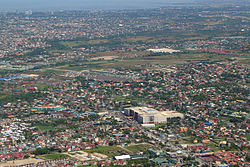“Cavite’s Gateway To The Metropolis”

History
Bacoor was was founded in 1671 and was named after bakod, Tagalog term for fence. Some accounts indicates that when Spanish troops arrived in “Bacoor”, they met some local inhabitants in the process of building a fence around their house. The Spaniards ask the men what the name of the city was, but because of the difficulties in understanding each other, the local inhabitants thought that the Spaniards were asking what they were building. The men answered “Bakood”. It was then pronounced in Spanish as “Bacoor” by the soldiers and was soon officially called “Bacoor”.
In the aftermath of the Philippine Revolution which coincided with the declaration of the first Philippine independence on June 12, 1898, Bacoor was designated as the first capital of the Philippine Revolutionary government by Gen. Emilio Aguinaldo until it was transferred to Malolos, Bulacan. “Gargano” was then the revolutionary name assigned to Bacoor by Aguinaldo’s revolutionaries.
During World War II, occupation troops from the Japanese Imperial armed forces entered the towns in Bacoor in 1942 during the Japanese Invasion. From 1942 to 1945, numerous Caviteño men and women joined the strong group of the recognized guerrillas under the Cavite Guerrilla Unit (CGU) and the Filipino-American Cavite Guerrilla Forces (FACGF) led by Colonel Mariano Castañeda and Colonel Francisco Guerero of the 2nd Infantry Regiment, FAGCF in the towns of Bacoor and arrival by the local Filipino soldiers under the ongoing 41st and the pre-war 4th and 42nd Infantry Division of the Philippine Commonwealth Army during the Japanese Occupation.
Population/ Language/ Area
The City of Bacoor (Filipino: Lungsod ng Bacoor or Siyudad ng Bacoor) is a first class urban component city in the province of Cavite, Philippines. It is a lone congressional district of Cavite. A sub-urban area, the city is located approximately 15 kilometers southwest of Manila, on the southeastern shore of Manila Bay, at the northwest portion of the province with an area of 52.4 square kilometers. Bordered to the east by Las Piñas City and Muntinlupa City in Metro Manila, to the south is Dasmariñas, to the west are Kawit and Imus and to the north by Bacoor Bay an inlet of Manila Bay. Bacoor’s is separated from Las Piñas by the Zapote River and from Imus and Kawit by Bacoor River.
According to the 2010 census of population conducted by the National Statistics Office, Bacoor has a population of 520,216 making it the second most populous community in the province after Dasmariñas. It also registered the highest average family income in Cavite in 1997 and 2000.
Products and Services
 Bacoor has developed into a site of commerce. Trade, banking and service sectors are Bacoor’s primary income earners. Commercial activities are sporadic throughout the city ranging from wholesale to retail establishments, restaurants and eateries, hardware and construction supplies and other service-related industries, especially those located in SM City Bacoor where it serves as the city’s main income earner. The mostly residential area of Molino is also home to SM Center Molino at the corner of Molino Road and Daang Hari. The entrance area from the Coastal Road to Aguinaldo Highway in Talaba and the area surrounding the Zapote Public Market (now the Bacoor Public Market) are other commercial centers. Bacoor has branches of 11 different commercial banks all over the city.
Bacoor has developed into a site of commerce. Trade, banking and service sectors are Bacoor’s primary income earners. Commercial activities are sporadic throughout the city ranging from wholesale to retail establishments, restaurants and eateries, hardware and construction supplies and other service-related industries, especially those located in SM City Bacoor where it serves as the city’s main income earner. The mostly residential area of Molino is also home to SM Center Molino at the corner of Molino Road and Daang Hari. The entrance area from the Coastal Road to Aguinaldo Highway in Talaba and the area surrounding the Zapote Public Market (now the Bacoor Public Market) are other commercial centers. Bacoor has branches of 11 different commercial banks all over the city.
Some of their natural industry include crops and fishponds, salt productions, fishing and oyster and mussel culture.
Business Opportunity
Hotels and restobars plaque the city as they offer accommodations to the tourists who usually pass in the city. Perfect businesses to put in the city are restaurants, hotels and other businesses that offer leisure activities.
Tourist Spots
Bacoor City is not really a tourist destination. It is actually one of the less visited places when it comes in tourism in the country. There are travelers who used the city as the passing area to some of the often visited cities such as Manila, Makati and Baguio.
But still the city continues to attract tourist through their hotels and restobars.

